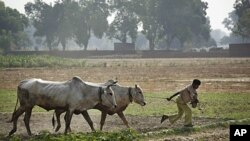The United Nations Food and Agriculture Organization says the world rice harvest for 2012 should top the 2011 crop, mainly because of gains in Asia. It says the harvest should rebound in Africa, but fall in the European Union and the United States.
Despite the upbeat forecast for rice production, the Food and Agriculture Organization's report notes that increased output has failed to translate into lower prices for consumers.
In its new report Friday, the FAO predicts world rice production at the paddy level will exceed 730 million metric tons for 2012 - up almost two percent from 2011.
FAO senior economist Concepcion Calpe says good harvests in Asia, in particular, will lead to a decline in demand in the global rice trade. Global trade is expected to fall by 900,000 tons to 34.3 million metric tons.
“This year because a lot of the major importers, like Indonesia or the Philippines or even Bangladesh first have harvested very good crops and second some of them - like the Philippines - they have declared they don’t want to import more than a certain amount. We see this is as the major factor behind the forecast decline in trade.”
But the FAO says higher costs for fuel, fertilizer and, in some countries, labor have kept rice prices above pre-2008 levels.
China, India, Burma, Pakistan, Thailand, Malaysia and Sri Lanka are all forecast to have bigger harvests in 2012.
The report says there are some concerns about the Bangladesh crop, as the La Nina weather pattern, with its erratic rainfall patterns, dissipates.
Rice production should rebound in Africa, led by Mali, Senegal and Nigeria. However, the FAO says drought and falling prices have pushed farmers in the European Union and the United States to shift to other crops. Production declines are also expected in Latin America and the Caribbean.
Calpe says official reports in China of record harvests appear to be contradicted by high domestic prices. “For our analysis, we rely a lot on the official forecasts of production for many countries, and in particular China. And, China year after year is saying that they are having record harvests. So these very good harvests are in contradiction with the very high prices that you see in the country today," she stated.
In Thailand, a government price-support program has led rice exports to fall by 20 percent, to less than eight million tons. The program keeps Thai rice export prices above market prices, so the FAO says, exporters such as India, Australia, Cambodia and Vietnam have captured a larger market share.
Calpe says Burma could become a significant exporter, as Western nations ease trade sanctions in response to the country's political and economic reforms. Foreign investment and productivity gains also will boost Cambodia’s rice output.




